My colleague Lynne Zolli and I have been working with two second grade teachers who teach nearby. We met them when Katherine taught my youngest grandson (then a second grader and now a seventh grader) and we “borrowed” her class to try out a lesson. It’s been a fine arrangement―Lynne and I continue to borrow their classes to test new lessons and individual math interviews, and they pick our brains for ideas.
Katherine and Brooke regularly incorporate math games into their instruction. Each Monday they teach a new game that the students play with their families for homework during the week. They also add the game to the class Math Menu. (If you’re interested, check out my previous blog, Using Math Menus.) Recently Lynne and I planned to visit on a Monday, and Katherine and Brooke asked for a suggestion for the week’s game that would give their students practice with addition strategies.
A Suggestion for a Math Game
I searched through books on my shelf and chose the game of Oh No! 99! from Math Workshop Essentials, a wonderfully useful and readable resource written by Rusty Bresser and Caren Holtzman. In the book, they explain the game and include a vignette describing how Caren taught the game to fifth graders to provide them mental addition practice that many still needed and how she extended it to push their thinking further.
Even though the resource is targeted for grades 3 through 6, I thought the game would work with the second graders. It did, and it was a terrific lesson!
Rules for Playing Oh No! 99!
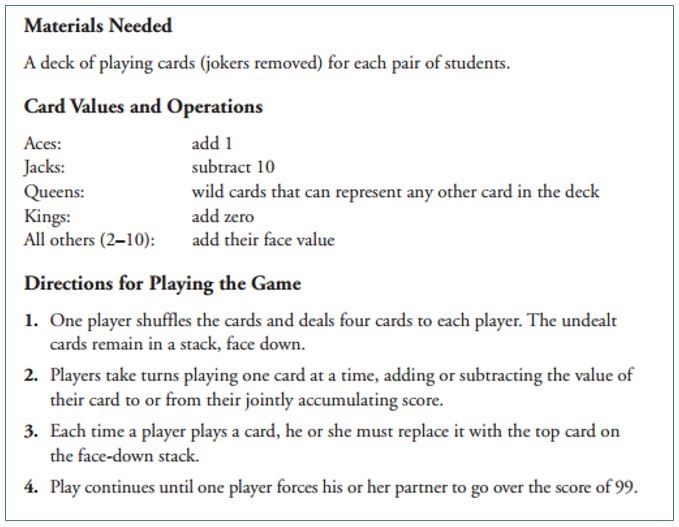
Prepare by Playing the Game First
When introducing any new game or activity, it’s important to try it first, and I recommend that you play Oh No! 99! before teaching it to your class. When we first tried following the rules, we weren’t exactly sure about what you could do with the Queens, and we thought that it would be important to clarify this for the students. We decided that when playing a Queen, you could add any number from 1 to 10. (In Rusty and Caren’s version, a Queen could also be used to add zero, like a King, or subtract 10, like a Jack. Both versions work fine. What’s important is that the students all play by the same rules and are clear about them.)
Playing helped us think about challenges that might arise and what we might anticipate as students played. It also helped us think about how we might structure a follow-up discussion. For example, we discovered from playing that the face cards were “good” cards to keep. We didn’t want to tell the students our ideas, but we wanted them to share and listen to each other’s thoughts about useful strategies.
Extra Support for Second Graders
Along with giving each pair of students a deck of cards, Katherine and Brooke also gave them a laminated 1–100 chart on which they could use a marker to keep track of the accumulating score. The chart was also a support for students who were less adept at adding mentally.
Two Different Ways of Introducing the Game
Brooke introduced the game by gathering the students on the rug, dividing them into two teams, and having each team move to one side of the rug so there was room to display cards in between. She explained the rules and selected students first from one team and then the other to choose a card and make a move. For this demonstration game, Brooke had both team’s four cards face up on the rug, but she told them that when they played, they’d each hold their own four cards in their hand so their opponent couldn’t see them. After playing the game twice, Brooke organized them into pairs to play. She also made the offer to any students who didn’t feel quite ready yet to play on their own to remain on the rug with her to play another practice game. As Brooke played with the students who needed more support, I circulated and offered help as needed. Not much was needed and the engagement was high.
Katherine introduced the game differently. She used the smartboard, chose one girl to be her opponent, and modeled the game for the class by playing with her. As Brooke did, she made the cards visible to everyone to engage them in suggesting possible moves, and she also explained that when they played with partners, they wouldn’t let their opponents see the cards they had. In Katherine’s class, Lynne worked with a pair of students that Katherine thought would need extra help, and Katherine circulated.
Ah, the luxury of having an extra person in the room. But don’t let that discourage you from trying this game. There’s always confusion when introducing something new, but the confusion is worth the effort.
What We Observed As Students Played
Observing the students as they play is useful as an informal assessment. As I circulated, I noticed some children reasoning in a variety of ways while others needed to count, either using their fingers or counting up on the 1–100 chart. When students added or subtracted 10, I looked for who just knew, who referred to the 1–100 chart to check the number directly above or below, and who used the 1–100 chart to keep track as they counted by 1s.
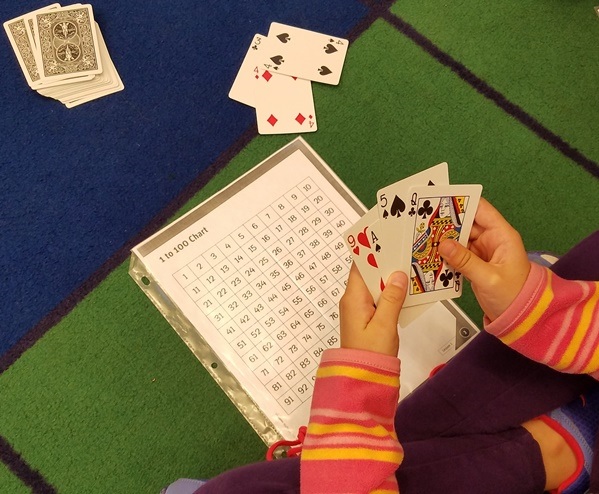
This girl kept the 1-100 chart close by, while others didn’t refer to it at all.
A Class Discussion
At the end of class, Brooke and I led a brief discussion. We asked the children for their ideas about the game. Some offered strategies: “Hold on to the Jacks.” “The Kings and Queens are really good cards.” Others had suggestions for improving the game: “Play so you can see each other’s hands.” One boy suggested, “Deal six cards instead of four so we have more in our inventory.”
Following Up with Number Talks
After class, Lynne and I talked about what might be a good way to follow up the students’ experience playing Oh No! 99! We thought about how Katherine and Brooke might use their morning number talks to focus on addition strategies, specifically on the strategy of “going to the next 10.” That night, I sent an email with two possible versions of number talks that connected to Oh No! 99! and would address this strategy, and also ideas to address strategies for adding 10 and adding 9.
A Number Talk Idea: Version 1
On the board write 38. Remind students about the game of Oh No! 99! Ask them to suppose that the number they’re up to is 38 and that a student plays this card. (Show the 2.) Ask: What would be the next number? (40) Write an equation on the board: 38 + 2 = 40.
Next show the 4 and ask: Suppose a student played this card instead. Ask for the answer. (42) Then ask a student to explain how to figure it out by using the strategy of going to the next 10 (or 40). What we’re looking for is decomposing the 4 into two 2s, then adding 38 + 2 to get 40, and then 40 + 2 to get 42. Record equations.
Continue with other numbers, asking students to figure out the answers by “making a ten” and then adding on the extra. It’s OK to do the numbers out of order. The final board work might look like this:
Start Number 38
Card Equations
2 38 + 2 = 40
4 38 + 2 = 40
40 + 2 = 42
7 38 + 2 = 40
40 + 5 = 45
Etc. (Continue adding other numbers to 38.)
Hmm, it might be useful to indicate how you decompose the number being added; e.g. 4 = 2 + 2 and 7 = 2 + 5
A Number Talk Idea: Version 2
Structure the number talk so it more closely simulates the game. Start the same way as for Version 1: On the board write 38, and remind students about the game of Oh No! 99! Ask them to suppose that the number they’re up to is 38 and that a student plays this card. (Show the 7.) Ask: What would be the next number? (45) Then ask a student to explain how to figure it out by using the strategy of going to the next 10 (or 40). Record equations. Record the new start number, show another card, and continue.
Start Number Card Equations
38 7 38 + 2 = 40
40 + 5 = 45
45 6 45 + 5 = 50
50 + 1 = 51
51 8 51 + 8 = 59
59 5 59 + 1 = 60
60 + 4 = 64
Etc. (Continue playing until you get to 99.)
It might be useful to repeat these sorts of number talks for a few days. Encourage students to use the strategy when playing and observe who is doing so and who may need additional support.
Two Additional Number Talk Ideas
It might also be useful to lead number talks that focus on adding 10. Linking to the 1–100 chart can especially benefit students who still need to count on by 1s when adding 10. And then it would be good to introduce the strategy for adding 9 by adding 10 and subtracting 1. Some students do this already. In a number talk, ask students to add 9 to several different numbers and record equations for two strategies: making a 10 and adding 10 and subtracting 1. For example:
Adding 9 Make a 10 Add 10, – 1
38 + 9 38 + 2 = 40 38 + 10 = 48
40 + 7 = 47 48 – 1 = 47
47 + 9 47 + 3 = 50 47 + 10 = 57
50 + 6 = 56 57 – 1 = 56
Revisiting on Friday
I went back to school on Friday and on this visit spent time in Katherine’s class. The children love, love, love the game. Fewer students were using the 1–100 charts.
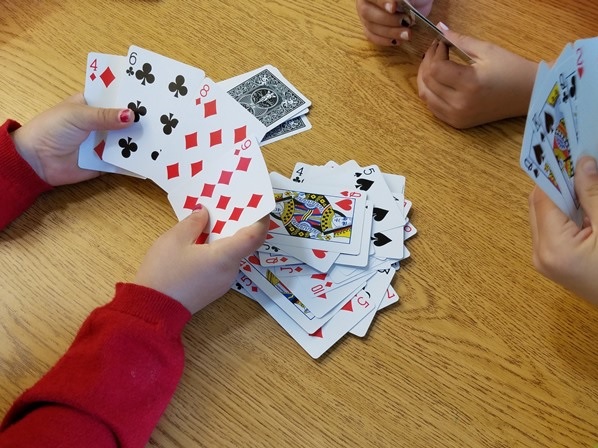
On Friday, Katherine had the students play in threes and it worked well. One boy told me it was even better because if the sum gets to 99, it could be the other person’s turn, and that person may have a Jack and bring the score down to 89, and then you’d still have a chance.
A Writing Follow-Up
At the end of class, I asked Katherine’s students to write about the game. I wrote three prompts on the board and asked them to choose one:
My strategy is . . .
The best cards are . . .
I like to play because . . .
I also wrote Oh no! 99! on the board and asked them to include that as a title on their papers.
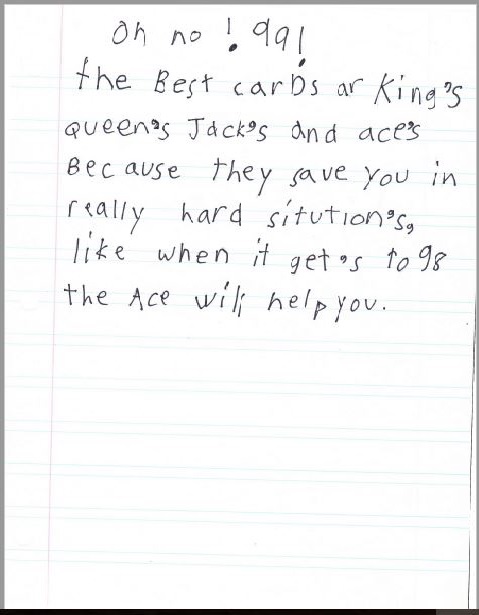
As children brought their papers up to me, I’d read them and often send them back to write more. For example, this boy first wrote: The best cards are kings, queens, jacks, and aces. I asked him to explain why they were the best cards and he added more to his paper. His paper shows his emerging understanding of when apostrophes are needed.

Some students, like this girl, used all three prompts when writing her paper.
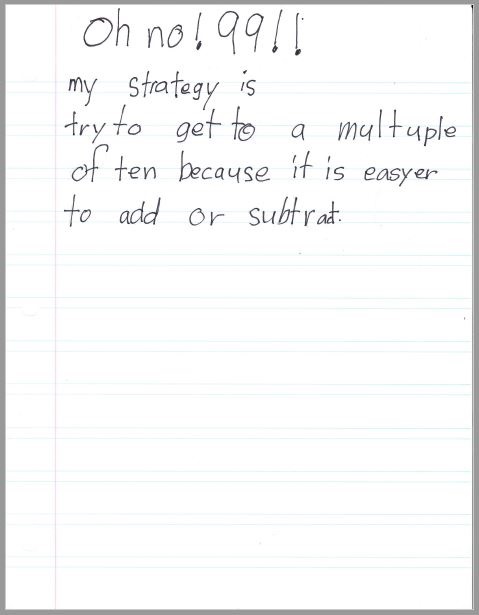
This student wrote about his idea for making adding and subtracting easier.
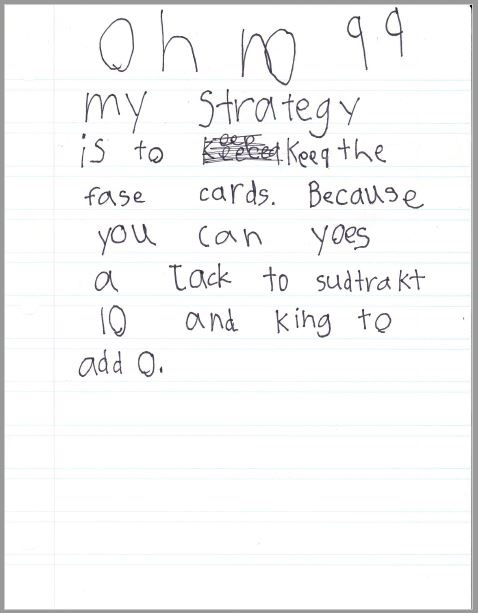
This student’s paper shows weaknesses in his writing but reveals that he had a firm grasp of a strategy for playing the game.
A Writing Assignment for Fifth Graders
When Caren taught the lesson in fifth grade, she gave the class this writing assignment:

Which card would you play? You can read samples of the fifth graders’ responses here.
A Last Note
The game is a version of O’NO 99, a commercial game that was brought to market in 1980 and is still available.

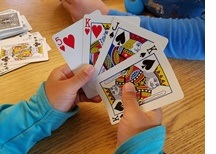
Great family cottage game! Interesting the variation in rules. At first we thought there was only 1 ‘correct’ set of rules (ours!) We have had Ace 1 or11, King 99, Queen add 10, Jack add 0, 10 subtract 10, 9 reverse order of turn, 2-8 add pip value ….. Marilyn, thanks for all you have done consistently through the years for Math teaching!!
Don Fraser Toronto. @DonFraser9
Thanks for your comment. It makes me think about ways to make the game more challenging for older students.
I’m playing a similar game in my class this week. I modified a game called 101 and out to 1001 and out. You play with dice and have 6 chances to get as close to 1000 without going over. The value of the dice is as follows: 1 dot- 10 or 100, 2 dots- 20 or 200, 3 dots-30 or 300, 4 dots- 40 or 400, 5 dots- 50 or 500, and 6 dots- 60 or 600. I’m working on adding multiples of 10s and 100s. I like your game because students need to use a strategy to decompose numbers to make adding easier. Can you think of a way to do this for 1000?
I’m familiar with 101 and out and I like how you modified it for 1001 and out. I’m not sure how to modify Oh No! 99!. Maybe if cards could be used as 10s or 1s (so that a 4, for example, could be 4 or 40) and they see how close to 100 they can get without going over. This might work if they were dealt six cards, and that was their hand — no more drawing cards. How could they use their six cards to get as close to 100 as possible. Do you think this would work?
Do you have copyright permission to share the instructions, etc. of this published game? I’d be concerned about using it if you do not and it is not (that I can see) given here. Please tell me that you do have that permisson. Thanks.
I appreciate your checking on the permission. OK to use! The instructions included in the blog come from Chapter 2 in the book I quoted and cited, and the link was provided to me by Math Solutions. There are also other references to the rules that I found from Google. The original commercial O’No 99 game is still available from various sites online. I hope you enjoy the game.
I wonder if an online solitaire version of it could be designed…
I would love to have you as one of my grandparents in the classroom!
I love to use dice in my classroom. We do a ton of dice math to work with numbers and number combinations. When we do play dice games my students get really excited. I love the Oh no 99! game. I can’t wait to try it next week!!!!
I wonder if the rules can be adapted for integers practice using the red and black cards.
Hah! I never thought of that. Thanks for the suggestion.
I love using a deck of cards in my classroom to reinforce math number sense. The students absolutely love the competition and game atmosphere. I have made the card games very simple with practicing multiplication facts in a fast paced “who knows it first” type game. I think the idea of having the students learn a new game each week and having to play it with their parents for homework is something that I will add to my math reinforcement activities each week. Excellent ideas!
I also love using cards in the classroom! What a great way to teach math.
Who created this game?
I wish I could remember so I could give it the proper attribution. It’s been part of my teaching repertoire for many years. It’s available as a card game (O’NO 99, first created in 1980. It has a Wikipedia entry:
This game is very similar to Zeus On The Loose from Gamewright.
In our family, we play that the winner of each round get’s to create a new “rule” for the next round – e.g. 2’s double the current score, One-Eyed-Jacks subtract 10, but Two-Eyed-Jacks subtract 20, when a player plays so that the score is a multiple of 10, they can draw 2 cards instead of one, etc. The ideas are endless!
We also play that there is a consequence if a player is caught not following a rule – e.g. they must discard a card. As the game continues, it becomes more and more interesting and also more difficult to remember all the rules. It is a lot of fun!
This is a wonderful idea. Thanks!